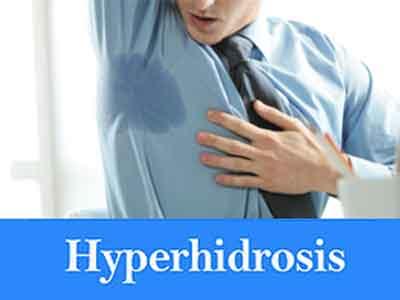- Home
- Editorial
- News
- Practice Guidelines
- Anesthesiology Guidelines
- Cancer Guidelines
- Cardiac Sciences Guidelines
- Critical Care Guidelines
- Dentistry Guidelines
- Dermatology Guidelines
- Diabetes and Endo Guidelines
- Diagnostics Guidelines
- ENT Guidelines
- Featured Practice Guidelines
- Gastroenterology Guidelines
- Geriatrics Guidelines
- Medicine Guidelines
- Nephrology Guidelines
- Neurosciences Guidelines
- Obs and Gynae Guidelines
- Ophthalmology Guidelines
- Orthopaedics Guidelines
- Paediatrics Guidelines
- Psychiatry Guidelines
- Pulmonology Guidelines
- Radiology Guidelines
- Surgery Guidelines
- Urology Guidelines
Hyperhidrosis Treatment available and effective but not sought: American Academy of Dermatology

NEW YORK — At least 15 million people in the U.S. experience diminished the quality of life due to excessive sweating, or hyperhidrosis. Many treatments are available, say dermatologists from the American Academy of Dermatology, and yet half of the people with the condition delay treatment for 10 years or more.
“We all sweat to some degree,” says board-certified dermatologist Maral Skelsey, MD, FAAD, director of the Dermatologic Surgery Center of Washington, DC and clinical associate professor at Georgetown University. “However, some people sweat heavily for years without realizing it’s a medical condition and that something can be done about it.”
Dr Skelsey notes that if a person is sweating buckets while exercising or sitting outside in the summer heat, that doesn’t necessarily mean he or she has hyperhidrosis. Hyperhidrosis causes excessive sweating when no triggers, such as temperature or activity level, are present. It affects adults and children in the armpits, feet, and hands and typically starts before age 25, with at least one episode a week. It does not cause sweating at night.
“It can be really devastating for children,” says Dr. Skelsey. “It affects their social life. Nobody wants to hold their hand. They can’t use crayons because they get all wet. They don’t want to go to school.”
For adults, it can affect big things like dating and career choices, as well as smaller things like clothing options.
“Hyperhidrosis can have a long-term impact if you constantly avoid professions or situations where you interact with people and shake hands,” says Dr Skelsey. “Additionally, people with hyperhidrosis are more likely to have attention deficit disorder, depression and anxiety, as well as other skin conditions like warts and eczema.”
The good news, says Dr Skelsey, is that there are several treatments out there for hyperhidrosis.
“Nobody has to live with this,” says Dr Skelsey. “There’s a lot we know about this condition. It doesn’t have to have such a profound effect on a person’s quality of life.”
For many people, prescription or over-the-counter clinical strength antiperspirants are effective when applied at night to the armpits or hands. Dr Skelsey says there are also new prescription topical wipes that can decrease the amount of armpit sweat in kids as young as nine years old.
- Botox injections in the armpits and hands are also used to treat hyperhidrosis, and most insurance plans will cover it.
- Dr Skelsey says iontophoresis is a good option for the hands and feet. The way it works is you put your hands or feet into a pan of water and a direct current goes into the water and enters the skin surface, blocking sweat production. The treatment is well tolerated and has limited side effects, says Dr. Skelsey, making it a good option for kids.
- The oral medication glycopyrronium is sometimes prescribed but can have side effects like dry mouth, constipation and urinary retention.
- Microwave thermolysis is usually not covered by insurance but is FDA approved, according to Dr. Skelsey. It uses electromagnetic energy to stop the sweat glands from functioning.
- A few patients choose laser surgery, which started being used to treat hyperhidrosis after doctors noticed that sweat glands were affected in people who had laser hair removal.
- Surgery to remove sweat glands is the last resort for people whose hand sweating doesn’t respond to other treatments.
The problem with surgery to remove sweat glands, Dr Skelsey says, is it can increase sweating elsewhere. The bottom line, according to Dr. Skelsey, is to talk to a board-certified dermatologist.
“There are so many treatments available that can improve patients’ daily life and quality of life substantially,” she says. “If one thing doesn’t work, there are other options.”

Disclaimer: This site is primarily intended for healthcare professionals. Any content/information on this website does not replace the advice of medical and/or health professionals and should not be construed as medical/diagnostic advice/endorsement or prescription. Use of this site is subject to our terms of use, privacy policy, advertisement policy. © 2020 Minerva Medical Treatment Pvt Ltd